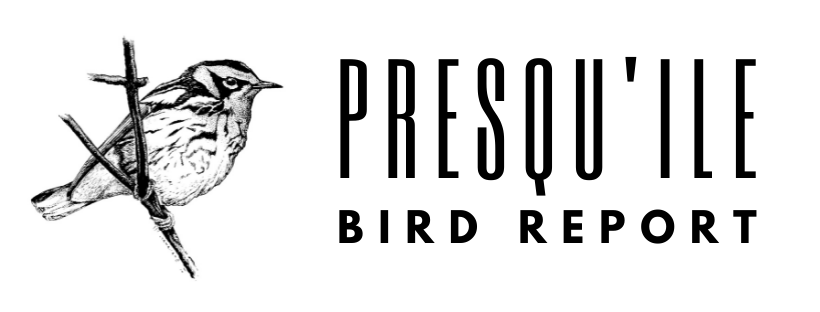
Highlights: CATTLE EGRET, LITTLE GULL, LAPLAND LONGSPUR, SNOW BUNTING
It was a good week for arriving migrants and by the end of the week the first taste of winter birding had arrived. Although coverage was still light, Gull Island was visited several times with nice results. The crossing to Gull Island presently involves three short water crossings (the widest being 20m). The third crossing is the deepest and it is best to have hip waders, but you can (barely) make the crossing in tall rubber boots if it is calm. Lake levels vary on wind-driven current and this area is very dynamic and can change quickly.
The first BRANT of fall was a single on Gull Is. on 14 Oct followed by 7 there on 18 Oct. Similarly the first TUNDRA SWANS were 4 seen on 13 Oct and 3 the next day. Puddle ducks are gathering in the marsh and around Gull Island where a high count of 42 GADWALL was made on 18 Oct. Diving ducks are also arriving in increasing numbers with several thousand now present in Presqu’ile Bay and north of Gull Island. LESSER SCAUP seem the most common but GREATER SCAUP and REDHEAD are mixed in. SURF and WHITE-WINGED SCOTERS have been seen all week and 4 BLACK SCOTERS were near Gull Is. on 18 Oct. Other northern ducks arriving this week include BUFFLEHEAD, COMMON GOLDENEYE, and the first LONG-TAILED DUCKS appeared on 18 Oct.
RUFFED GROUSE and WILD TURKEY were noted at several sites this week, including 4 of the latter in extended flight over the causeway marsh on 15 Oct. HORNED GREBES are being seen commonly around the islands with a peak count of 120 on 18 Oct. An AMERICAN BITTERN and a GREAT EGRET were reported from the causeway marsh on 13 Oct. A great find was the 2 immature CATTLE EGRETS that spent the morning of 17 Oct on the grass ramparts of the Brighton Sewage Lagoon. Subsequent searches have failed to find them but any area with livestock should be carefully checked.
Raptor migration continues, especially on days with northerly winds. TURKEY VULTURES have been the most obvious but SHARP-SHIINED and COOPER’S HAWKS are also being seen regularly, as well as NORTHERN HARRIER. An adult BALD EAGLE was seen at several locations near the beach on 18 Oct. Buteos are often scarce in the Park because most migrant raptors follow close to the east-west shoreline, passing by just north of the Park. An adult RED-SHOULDERED HAWK was seen on Huff Rd., just NW of the gate on 12 Oct.
It was a good week for shorebirds with 13 species reported, most of which were on Gull Is. Among the more common BLACK-BELLIED PLOVER was a single AMERICAN GOLDEN PLOVER on 18 Oct. and 3 SEMIPALMATED PLOVER on 14 Oct and a single on 18 Oct. A flock of 14 GREATER YELLOWLEGS was seen on 18 Oct. just outside the gate, and presumably the same group landed at Owen Pt. a few hours later. A single LESSER YELLOWLEGS was noted on 14 Oct. The two most common shorebirds were DUNLIN and SANDERLING with high counts of 125 and 35 respectively on 18 Oct. One adult DUNLIN on 18 Oct was still largely in breeding plumage with a substantial black belly patch and much rufous feathering in the back. Small numbers of WHITE-RUMPED SANDPIPERS have been present much of the week with a high on 5 – a late adult and 4 juv. - on 18 Oct. PECTORAL SANDPIPERS peaked with a group of 12 on 18 Oct. Lingering SEMIPALMATED SANDPIPERS have been reported several times with a high count of 4 on 18 Oct. Similarly a few LEAST SANDPIPERS were also reported through the week. Finally both AMERICAN WOODCOCK and WILSON’S SNIPE were seen flying over the causeway marsh at dusk on the 13th and 14th.
Gull numbers have picked up considerably this week with HERRING and RING-BILLED being most common. A big influx of BONAPRATE’S GULL arrived on the 18th with a peak count of 575 around Gull Is. and with them was a beautiful adult LITTLE GULL. Large numbers of gulls, cormorants and mergansers can often be seen far offshore in feeding swarms. Most of the time these flocks are distant making ID difficult but they are worth scrutiny for rarer pelagic species when closer to shore.
MERLINS are reported daily and a PEREGRINE FALCON was seen on 14 Oct. Flycatchers are pretty much gone now except for EASTERN PHOEBE, which was reported throughout the week in small numbers. Over the past 20 years COMMON RAVENS have re-occupied their historical breeding range south of the Canadian Shield and sightings here are no longer unusual, however 8 flying together over the marsh on 17 Oct likely represents a new one-time high count.
2 HORNED LARKS were on Gull Is. on 18 Oct. It became clear this week that a large passage of BLACK-CAPPED CHICKADEE is occurring with multiple sightings of flocks in unusual places such as Gull Is. and the beach area. The peak count was 250 on 14 Oct. An EASTERN BLUEBIRD was just outside the gate on 17 Oct. Two late sightings of single SWAINSON’S THRUSH were reported on 17 and 18 Oct. An AMERICAN PIPT was on Gull Is. on 18 Oct. Another northern breeder that passes through in small numbers is LAPLAND LONGSPUR with the first two being seen on Gull Is. and Owen Pt. on 16 Oct. Speaking of winter, three single SNOW BUNTINGS were also noted on Gull Is. on 18 Oct.
YELLOW RUMPED WARBLERS were seen in small numbers throughout the week, but alongside were some species at or beyond their “normal” departure dates. These include an ORANGE-CROWNED on 18 Oct, several NASHVILLE up to a single on 17 Oct, a BLACKPOLL just outside the gate on 13 Oct , a PINE on 13 Oct , multiple PALM to 17 Oct and COMMON YELLOWTHROAT on 13 Oct.
Sparrows were widespread this week with less commonly seen species including EASTERN TOWHEE on 14 Oct, FIELD SPARROW on 14 Oct and FOX SPARROW on 13 Oct. Large numbers of DARK-EYED JUNCO, WHITE-CROWNED, WHITE-THROATED and SONG SPARROW could be found at several areas within the Park.
A RUSTY BLACKBIRD was noted on 17 Oct. Finch movements were also noticeable with PURPLE FINCHES being widespread in small numbers, and both PINE SISKIN and AMERICAN GOLDFINCH are increasing with flocks being seen daily at scattered sites.
Note that fall waterfowl hunting in now occurring in the Park which means park users cannot go to Owen Pt., the islands, the marsh (boardwalk is open), or Calf Pasture Pt. on Saturdays, Mondays, Wednesdays or Fridays even if no one is hunting on those days. This restriction will last until mid December so plan your trip accordingly.
Presqu’ile Provincial Park is located on the north shore of Lake Ontario, just south of the town of Brighton. It can be reached from either Hwy. 401 or Cty. Rd. 2 and is well signed. A Park map can be found in the information tabloid available at the Park gate. Presqu’ile’s two offshore islands – Gull and High Bluff – support a large multi-species colonial bird nesting area and access is not permitted during the breeding season.


